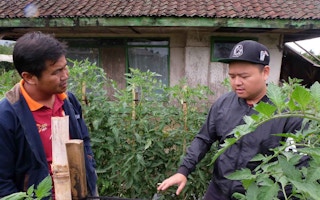What if rural, smallholder farmers in Asia could harness the power of digital technology to access solutions that were previously within reach of only wealthy, large-scale farmers and agribusiness corporations?
To continue reading, subscribe to Eco‑Business.
There's something for everyone. We offer a range of subscription plans.
- Access our stories and receive our Insights Weekly newsletter with the free EB Member plan.
- Unlock unlimited access to our content and archive with EB Circle.
- Publish your content with EB Premium.
Their labourious work supporting the global production of food and other consumer products would be more productive and profitable, and make farming, a waning profession in Asia, more attractive to young people, according to Paul Voutier, director for knowledge and innovation at Grow Asia, a Singapore-based, multi-stakeholder partnership platform that seeks to improve farmer livelihoods.
In Africa and Asia, smallholder farmers make up the backbone of developing economies, reportedly providing over 70 per cent of the food consumed globally. However, they remain some of the poorest people in the world, due to physical and financial barriers such as low productivity, land insecurity and a lack of access to information and finance.
Their livelihoods are also impaired by unethical and unsustainable practices by large agribusiness corporations, such as land-grabbing and the monopolisation of technology. Smallholder farmers that depend on agriculture to survive are also the most vulnerable to the impacts of climate change.
Furthermore, in countries like Indonesia, rising urbanisation is predicted to result in 8 million fewer farmers by 2030 as people migrate from the countryside to cities. In Vietnam, the agricultural workforce is predicted to fall 27 per cent between 2000 and 2022, with more young people leaving the farming sector because of the lack of capital and negative perceptions around farming.
“We believe that digital solutions are critical to addressing many of the challenges we see in agriculture in the region,” said Voutier at the launch of Grow Asia’s Digital Directory, a free, online platform that features over 60 innovative agri-tech solutions.
Created in partnership with the Inclusive Business Action Network (iBAN), a global initiative focused on scaling up inclusive business models, the Digital Directory serves to make digital solutions more visible to farmers and other agricultural stakeholders in Southeast Asia.
Hoping that the directory becomes a go-to resource for investors and agribusinesses interested in digitising smallholder farming, Voutier revealed that the primary goal is to help the region’s smallholders get access to training, supply chain intelligence, traceability and financing.
According to him, this could strengthen their role in the global production of food, and help lift them out of poverty.
Small farming goes digital
“Our farmers are the ones who provide food on the table but we are some of the poorest compared to others working in the industry. There must be something wrong with the agricultural supply chain,” said Yohanes Sugihtononugroho, chief executive founder of CROWDE, an Indonesian agri-tech startup in the Digital Directory that helps connect farmers to potential investors.
Through CROWDE’s mobile crowdfunding application, anyone can invest as little as USD$1 in thousands of farms across the country and help finance agricultural projects such as distributing coffee beans and transporting watermelons over long distances.
“
“Our farmers are the ones who provide food on the table but we are some of the poorest compared to others working in the industry.”
A former chili, mushroom and poultry farmer himself, Sugihtononugroho shared with Eco-Business that the challenges faced by smallholders in Indonesia stem from the lack of access to information, technology and finance, all of which decides whether farmers will enter “an endless cycle of poverty.”
“Digitalisation allows farmers that were once disconnected and isolated to be exposed to new solutions that are currently out there to help farmers. It also allows them to connect to every stakeholder and make the supply chain more efficient,” he added.
According to Sugihtononugroho, CROWDE has helped to increase farmers’ income from USD$50 a month to USD$150, and improve the quality of their yield while also reducing the amount of food loss.
Elsewhere in the region, agri-tech venture Impact Terra leverages on mobile technology to help farmers in Myanmar improve both their livelihoods and local food production, while reducing agriculture’s negative impact on the environment.
“I saw an opportunity to leverage the quickly increasing smartphone penetration in Myanmar—from 0 per cent to 80 per cent in a couple of years—and the availability of low cost data to support the Myanmar people in one of the most important sectors: agriculture,” said Erwin Sikma, founder of Impact Terra.
The company’s free digital platform Golden Paddy provides practical farming-related information, advice and data insights through three channels: the Golden Paddy mobile application, web-app and Facebook page.
According to Sikma, farmers plugged into the platform now have better access to reliable information, financing and markets, allowing them reduce crop and food loss after harvesting, and run their business more efficiently.
“If you go to a field or farm in Myanmar, you will see farmers walking around with one or several smartphones,” said Sikma. “As they start seeing the possibilities offered by increased communication and access to information, they now see how being connected can also create value for their families and business.”










